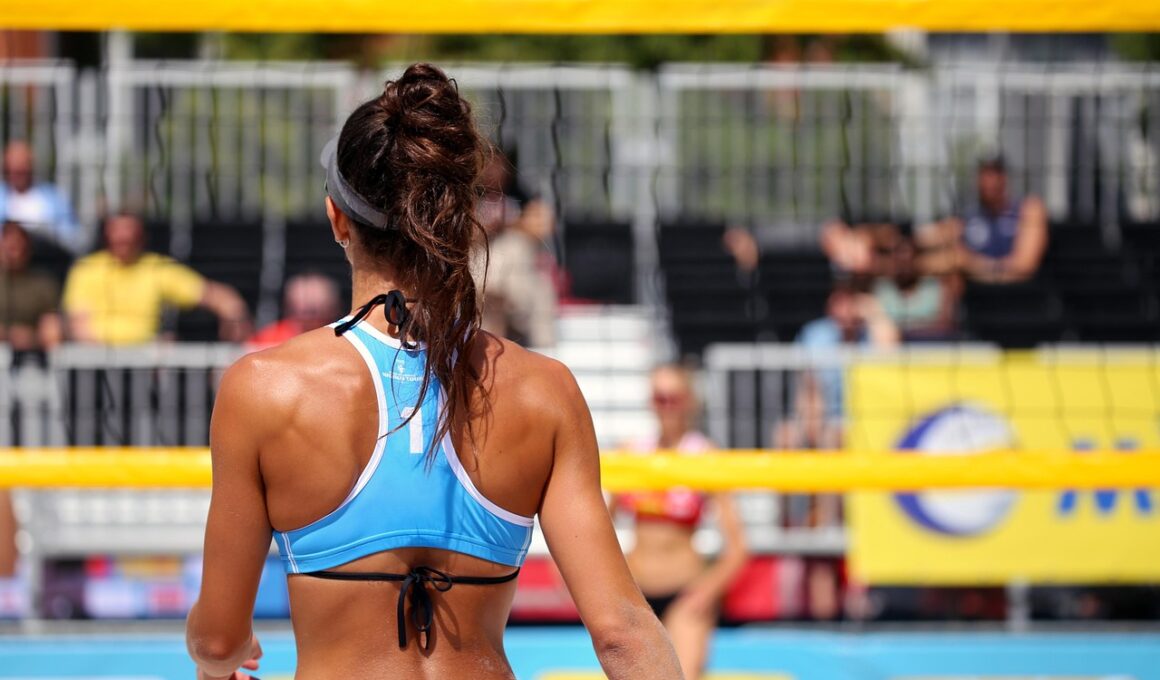Integrating Strength and Conditioning into Volleyball Drills
When it comes to advanced volleyball training, integrating strength and conditioning is crucial for enhancing performance. Strength training focuses on increasing muscle power and endurance, which are vital in volleyball. Conditioning workouts improve cardiovascular fitness, allowing players to sustain energy throughout intense matches. Effective drills should combine technical skills with these physical demands. Coaches can design drills that alternate between skill execution and physical challenges. For instance, players can perform passing, then immediately engage in a sprint, developing both volleyball tactics and fitness simultaneously. Another effective drill is the incorporation of plyometrics to improve jumping ability. Vertical jumps before hitting drills enhance explosive power necessary for spiking. Additionally, agility drills, such as ladder exercises, can greatly benefit footwork. Integrating interval training can boost players’ aerobic capacity, making it easier to recover between points. Ultimately, developing a strong foundation in strength and conditioning translates to better performance on the court. By blending these elements into practice routines, coaches foster well-rounded athletes capable of excelling in volleyball competitions and adjusting to the physical demands of the sport.
The effectiveness of strength training in volleyball cannot be overstated. Not only does it build muscle strength, but it also minimizes injury risk. Volleyball players are prone to various injuries, particularly in the shoulders and knees. A program tailored to enhance muscle stability will significantly reduce such risks. Incorporating resistance bands and weights into drills can build the necessary strength around crucial joints. This method enhances not just power but also the player’s overall stability. Benefits of incorporating strength training sessions are numerous. For example, athletes observe improved vertical leaps alongside more powerful serves and spikes. Also, strength training fosters better body alignment, which is essential in executing tactical plays. Balance and core strength exercises contribute to players’ ability to transform quickly to address defensive needs. Furthermore, the use of specialized equipment, like medicine balls, can simulate on-court movements, improving functional strength. Coaches should prioritize incorporating these elements into regular trainings. The integration of conditioning routines, such as high-intensity interval training, ensures that players maintain optimal energy levels during extensive matches.
Importance of Plyometric Exercises
Plyometric exercises are particularly beneficial for volleyball players aiming to enhance explosive strength. By incorporating explosive movements, players can increase their vertical leap and speed, both crucial for spiking and blocking. Some popular plyometric drills include jump squats and box jumps, targeting the lower body muscles. Within practice, these can be combined with skill drills, allowing players to practice jumping techniques tied directly to game scenarios. For instance, executing a series of box jumps immediately followed by a spike can improve the transition from physical exertion to skill execution. Players should focus on landing softly and maintaining form to maximize benefits effectively while reducing injury potential. Coaches can monitor their athletes to ensure proper technique is used during plyometrics. Gradually increasing the difficulty can help prevent plateaus in strength gains. The endurance aspects should not be overlooked; integration of exercises that require quick changes in direction improves overall agility. Fostering an athlete’s ability to switch rapidly can greatly enhance their performance in dynamic game situations. Overall, integrating plyometric training into daily drills can significantly impact an athlete’s competitive success.
Another critical area of focus during strength and conditioning integration is core stability. A strong core improves balance and body control, two essential components of volleyball. Core exercises like planks, Russian twists, and stability ball exercises can provide substantial benefits. Coaches can pair these exercises with volleyball movements, creating functional training that translates to improved performance on the court. Strengthening the core aids in the transfer of force generated in the lower body to the arms, essential for powerful serves and spikes. Further, stable athletes can maintain better body alignment, minimizing the risk of injury. It assists in performing quick maneuvers, contributing to faster movements in response to the game. Incorporating medicine balls and balance boards can help in developing endurance while engaging core muscles. Coaches should emphasize variety in core routines to keep athletes engaged and challenged. By prioritizing core stability throughout training sessions, coaches foster resilient, agile athletes capable of adapting to various gameplay dynamics. Furthermore, athletes can implement these techniques into their daily routines for better performance during off-court training sessions.
Building Agility and Speed
Agility and speed are paramount skills in volleyball, impacting both offensive and defensive plays. Therefore, training drills must focus on enhancing these abilities to prepare athletes for unpredictable game situations. Ladder drills can improve foot speed and coordination, enabling players to move more efficiently on the court. Adding cones into practice can develop sharp agility by forcing players to change directions abruptly while maintaining control over their movements. These drills can be incorporated into warm-ups or during skill assessments, maximizing overall efficiency in training sessions. Another effective approach is utilizing sprint intervals on the court, enhancing explosive speed. Sprinting drills should stimulate game situations where quick bursts of speed are required. Coaches can design competitive scenarios, encouraging athletes to push their limits while maintaining technical skills. By blending agility drills with volleyball-specific skills, players reinforce their operational understanding of the game. The integration of resistance bands during sprint training challenges players further, improving acceleration and resilience. This method encourages athletes to engage their full range of muscle groups, fostering well-rounded technical proficiencies on the court.
Nutrition plays a vital role in the overall effectiveness of strength and conditioning programs in volleyball. Athletes require proper nutrients to fuel their workouts and recover afterward. A balanced diet comprising carbohydrates, proteins, and fats ensures optimal energy levels during training and games. During rigorous training, hydration becomes equally crucial, as dehydration can lead to diminished performance and fatigue. Coaches must educate players on the importance of meal timing, particularly around workout sessions. Pre-workout meals should focus on energy-dense foods that provide sustained energy. Post-workout nutrition becomes essential in recovery, requiring protein intake to help repair and build muscles. Incorporating recovery strategies into the routine, such as stretching and cooldowns, will enhance muscle orientation. Athletes must understand their unique nutritional needs to perform optimally throughout the season. Additionally, considering personalized plans can cater to individual preferences and energy requirements while responding to the intensity of training regimens. Proper nutrition directly impacts performance, resilience against injuries, and transition back to regular play safely. By meticulously curating dietary habits, coaches empower athletes to achieve peak performance levels.
Monitoring Progress and Adaptation
Monitoring progress is essential to ensure the effectiveness of strength and conditioning integrated drills. Coaches should consistently evaluate athlete performance through assessments, allowing for adjustments tailored to individual needs. Regular testing can measure improvements in agility, strength, and endurance. Implementing fitness tests, such as vertical jump tests, sprinting trials, and endurance assessments, can provide valuable data on performance. This information can help trainers identify areas where athletes excel and areas that require further development. Feedback based on these evaluations empowers athletes to set personal goals, enhancing motivation and commitment to continuous improvement. Creating a well-structured adaptation plan ensures athletes develop at their respective paces, avoiding burnout or injury. Coaches can opt for periodized training, allowing fluctuations in intensity and volume that adapt to competition schedules. Flexibility in training also encourages athletes to address weaknesses while enhancing their skills. Continuous learning through workshops and seminars on strength and conditioning can keep coaches updated on innovative training techniques. Using technology to track performance advances training methods, helping cultivate competitive athletes ready to succeed at high levels.
In conclusion, integrating strength and conditioning into advanced volleyball drills is essential for maximizing athlete performance. A well-rounded program incorporating training elements can significantly impact on-court success. Coaches play a pivotal role, designing routines that focus on developing strength, agility, conditioning, and nutrition. Through structured drills, athletes gain comprehensive skills to navigate intense game scenarios. Moreover, effective recovery strategies support sustained performance, ensuring players remain competitive throughout the season. Coaches should prioritize continual monitoring to adapt training to individual needs, fostering improvement and resilience among athletes. The integration of plyometrics, core stability exercises, and nutrition educates players on vital components contributing to athletic excellence. Since volleyball is a physically demanding sport, the importance of strength and conditioning cannot be underestimated. Engaging athletes with varied and challenging drills will maintain interest while ensuring they gain the specific skills required for volleyball. Ultimately, a commitment to integrating these essential elements will pave the way for developing high-performing volleyball players capable of thriving at all levels.


